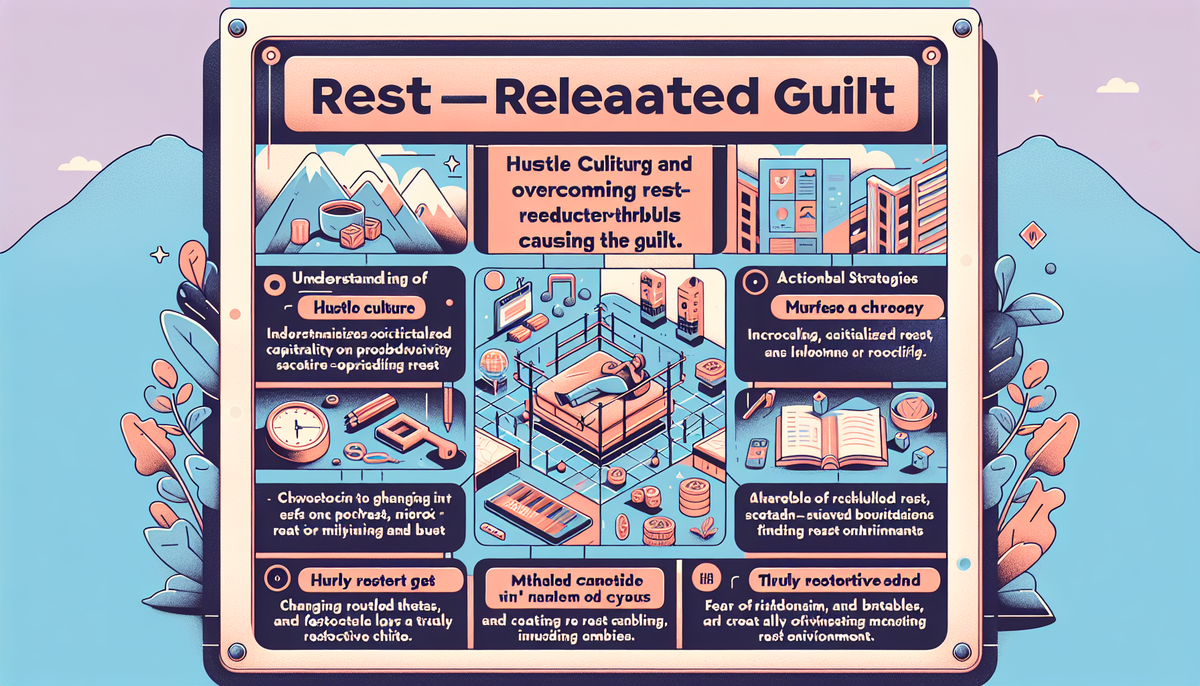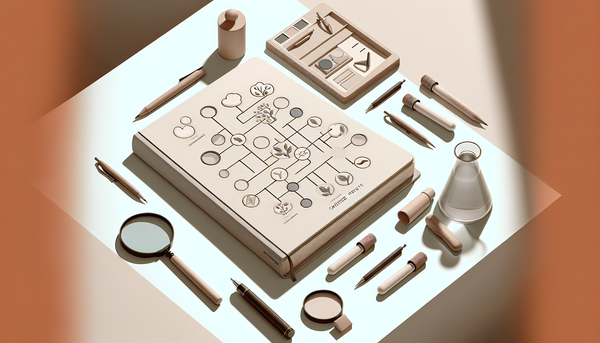How to Rest Without Feeling Guilty

If you’ve ever felt a pang of guilt the moment you sit down to rest, you’re not alone. Many high-achievers and caring, responsible people struggle to relax without questioning whether they’re doing enough. The pressure to constantly produce can make rest feel like a luxury you have to earn rather than a basic human need. But guilt-free rest is not indulgence; it is maintenance. It is the foundation that supports your health, clarity, creativity, and sustainable productivity. This article explains why we feel guilty about resting, then offers practical, evidence-informed strategies to help you recharge without the mental tug-of-war.
Understanding the Roots of Rest-Related Guilt
Rest-related guilt rarely appears out of nowhere. It is shaped by the norms we absorb, the beliefs we internalize, and the comparison culture we swim in. Understanding the roots of this guilt helps you recognize it as a conditioned response rather than a personal flaw. Once you see where it comes from, you can challenge it with compassion and choose healthier habits that support your well-being and performance.
The "Hustle Culture" Phenomenon
Modern hustle culture glorifies constant busyness. When social feeds and office conversations showcase late nights, back-to-back meetings, and side projects, it creates a norm where rest looks like slacking. This environment rewards immediate visibility over long-term sustainability. The result is a bias toward doing more now and paying the cost later in the form of burnout, decision fatigue, and diminishing returns. In workplaces that equate “always on” with “committed,” it can feel risky to take a break. But the paradox is clear: the people who pace themselves, protect their focus, and recharge regularly are the ones who think better, produce higher-quality work, and last longer. Rest is not the enemy of results; it is the engine of them.
Internalized Capitalism and Productivity
Internalized capitalism is the tendency to tie your self-worth to your output. When productivity becomes identity, pauses feel like threats to who you are. You may feel compelled to justify rest by promising extra work later or by labeling it as “productive rest” only if it directly improves performance. This mindset also ignores the full spectrum of human needs: mental, emotional, social, physical, and creative. Over time, self-criticism ramps up, perfectionism becomes more rigid, and the bar keeps moving. Recognizing this pattern helps you separate your value from your to-do list. You are worthy of rest simply because you are human, not because you’ve checked enough boxes.
The Fear of Missing Out (FOMO)
Constant connectivity fuels the belief that opportunities are slipping away if you disconnect. Social media shows everyone’s highlight reel. Work tools ping at all hours. News cycles churn. This ambient urgency creates FOMO around both social life and career progress. When you finally decide to rest, the pull to check, scroll, or respond can feel irresistible, which then fragments your downtime and leaves you neither rested nor caught up. Reducing exposure to comparison triggers and notification noise is essential to silencing FOMO and reclaiming the mental space that true rest requires.
Actionable Strategies for Guilt-Free Rest
Rest becomes easier when you treat it as a skill you can design and practice. The following strategies help shift your mindset, protect your time, communicate your needs, and select activities that truly replenish you. Used together, they convert good intentions into a steady rhythm of renewal that supports your best work and a life you enjoy living.
Mindset Shifts for Embracing Rest
Reframe rest as a performance and health strategy. Athletes build rest into training cycles because recovery is when muscles repair and strength improves. Your brain and nervous system work the same way. Recovery is when memory consolidates, creativity recombines ideas, and stress hormones recalibrate. Instead of thinking “I’ll rest after I finish everything,” shift to “I rest so I can finish what matters well.” Replace productivity-as-worth with values-driven living: relationships, learning, contribution, and health all require energy that rest restores. Practice self-talk that normalizes rest: “Rest protects my focus,” “Downtime is part of the job,” and “I’m allowed to pause.” When guilt surfaces, label it as a conditioned response rather than a command; then return to your planned rest with intention.
Scheduling Rest Like an Appointment
If rest is optional, it will be the first thing to go. Put it on your calendar just like a meeting or workout. Use time-blocking to allocate short breaks daily, a longer block weekly, and a reset monthly. Protect these blocks with the same seriousness you give to commitments with others. Add context to the calendar entry: “No email,” “Walk without phone,” or “Reading for joy.” Set reminders that cue you to step away before you’re depleted, not after. Pair rest with existing routines to automate it: a 10-minute wind-down after lunch, a short walk before your last work block, or a screen-free hour before bed. Treat skipped rest as a deviation worth correcting next time rather than proof you can do without it.
Setting Boundaries and Communicating Needs
Boundaries prevent other people’s urgency from consuming your energy. Clarify response expectations: tell colleagues your typical response windows and set an out-of-office or status note during deep work and rest. Offer alternatives when you decline: “I’m offline after 6 p.m.; if urgent, call me. Otherwise I’ll reply by 10 a.m. tomorrow.” At home, align on quiet times, chore rotations, and tech-free zones that protect everyone’s downtime. When you communicate clearly, respectfully, and consistently, people learn your rhythms and adjust. Boundaries are not walls; they are agreements that make collaboration sustainable.
Finding What Truly Recharges You
Not all breaks are restorative. Doomscrolling or half-watching a show while answering emails keeps your brain in standby, not rest. Identify activities that genuinely lower your stress and replenish your energy. Consider the seven types of rest: physical (sleep, stretching), mental (single-tasking, daydreaming), sensory (quiet, dim light), emotional (journaling, therapy, honest conversation), social (time with energizing people or time alone), creative (art, music, nature), and spiritual (reflection, values alignment, gratitude). Experiment and observe what leaves you calmer, clearer, and more present afterward. Keep a short list of go-to micro and macro recharge options so you can choose based on the time you have and the kind of fatigue you feel.
Integrating Recharge Tips into Your Daily Life
Consistency matters more than intensity. You can weave rest into the edges of a busy schedule without derailing your goals. Start small, build momentum, and let your practices evolve with your seasons of life and work. When rest becomes part of your routine, guilt fades because it’s no longer a debate; it’s just what you do.
Micro-Rests for a Busy Schedule
Micro-rests are short, intentional breaks that interrupt stress buildup before it becomes exhaustion. Try a 90-second breathing reset with a slow exhale, a two-minute stretch for neck, hips, and wrists, a five-minute phone-free walk, or a quick posture check and gaze shift to a distant view to relax eye strain. Use natural transitions—after a meeting, before a call, or when switching tasks—to insert small breaks. If you like structure, use the Pomodoro approach: 25 minutes focused, 5 minutes off; after four cycles, take a longer 15–30 minute break. The goal is not to be idle; it’s to reset your nervous system so focus and creativity stay sharp.
Themed Rest Days or Weekends
Longer, themed rest periods deepen recovery and keep rest engaging. Choose a focus that matches your needs. A digital detox day: remove nonessential apps from your home screen, set do-not-disturb, print directions, and plan offline activities like cooking, hiking, or reading. A creative weekend: gather supplies in advance, pick a simple project, and let yourself make something badly for the joy of it. A nature immersion: spend hours outside, aim for unstructured time, and let your senses recalibrate. A connection day: slow meals, meaningful conversations, and shared activities with people who energize you. Reduce friction by planning basics—food, supplies, and logistics—so you don’t spend your rest managing errands.
Creating a Rest-Inducing Environment
Your space can either agitate or soothe you. Design simple cues that signal “it’s time to rest.” Light: use warmer, dimmer light in the evening and limit blue light an hour before bed. Sound: reduce noise with soft music, white noise, or silence; consider noise-canceling headphones for micro-rests in busy environments. Clutter: keep one surface clear in each room to lower visual load; create a “landing zone” for devices and keys to reduce decision fatigue. Comfort: invest in a supportive pillow or chair, keep a blanket or eye mask nearby, and adjust temperature to preference. Tech boundaries: charge devices outside the bedroom, use app limits for evenings, and create a “phone basket” during meals or conversations. These small environmental tweaks lower the activation energy required to rest.
Conclusion
Rest-related guilt thrives in cultures that celebrate output and overlook recovery. By understanding the forces that shape your feelings—hustle norms, internalized productivity beliefs, and FOMO—you can choose a healthier path. Shift your mindset to view rest as a strategic investment, schedule it as a non-negotiable appointment, communicate boundaries that protect your energy, and pick activities that truly replenish you. Start small but steady. Choose one tip to implement today: add a five-minute breathing break to your calendar, block a screen-free hour this evening, or set a simple boundary about your response times. Guilt-free rest is not a reward you earn after working hard; it is a practice that makes your work and your life better.



